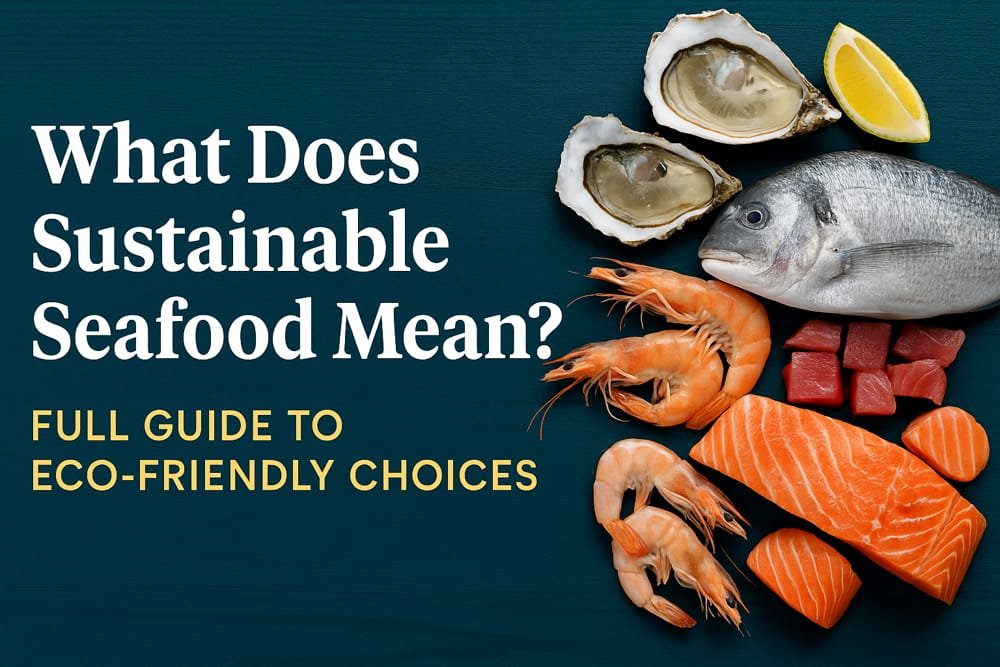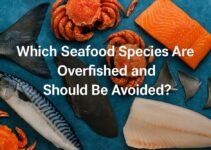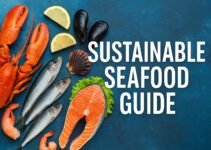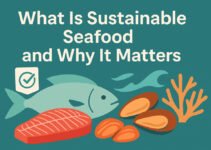Seafood plays a critical role in global nutrition, yet the way it is sourced directly impacts the health of our oceans and future food security. With nearly 3.3 billion people relying on seafood as a primary protein source, understanding what sustainable seafood means is no longer optional—it’s essential. Consumers often encounter labels like “sustainably sourced” or “eco-friendly seafood” without fully understanding their implications.
This guide will provide clear, verifiable answers about sustainable seafood, focusing on its environmental, economic, and health-related impacts. You will learn how to identify truly sustainable seafood, the certifications that matter, and why making informed choices supports both marine ecosystems and responsible fishing communities. By the end of this article, you’ll have actionable knowledge to confidently purchase seafood that aligns with environmental conservation and promotes healthier consumption habits.
Contents
- 1 What Is the Exact Definition of Sustainable Seafood?
- 2 Why Is Sustainable Seafood Important for Ocean Ecosystems?
- 3 How Does Unsustainable Fishing Contribute to Environmental Damage?
- 4 What Are the Official Certifications for Identifying Sustainable Seafood?
- 5 What Are the Differences Between Wild-Caught and Farm-Raised Sustainable Seafood?
- 6 Which Types of Seafood Are Considered the Most Sustainable?
- 7 How Can Consumers Make Environmentally Responsible Seafood Choices?
- 8 What Are the Economic Benefits of Choosing Sustainable Seafood?
- 9 Can Eating Sustainable Seafood Improve Your Health?
- 10 How Is Climate Change Impacting Seafood Sustainability?
What Is the Exact Definition of Sustainable Seafood?
Sustainable seafood refers to fish and shellfish sourced in ways that maintain healthy populations, minimize environmental impact, and support local economies.
The Marine Stewardship Council (MSC) defines sustainable seafood as seafood caught or farmed with minimal impact on marine environments and in ways that ensure long-term species viability. Similarly, the Food and Agriculture Organization (FAO) outlines that sustainable fisheries must comply with regulations that prevent overfishing and support ecosystem health.
There are two main categories of sustainable seafood:
- Sustainable Wild-Caught Seafood: Harvested using regulated methods that prevent overfishing and protect marine habitats.
- Sustainable Farm-Raised Seafood: Produced through aquaculture practices that limit pollution, reduce antibiotic use, and prevent disease outbreaks.
This distinction helps consumers choose products that contribute to ocean preservation and responsible food production systems.
Why Is Sustainable Seafood Important for Ocean Ecosystems?
Sustainable seafood practices are essential to preserving ocean ecosystems by preventing species collapse and maintaining biodiversity.
According to the FAO’s 2022 report, over 35% of global fish stocks are currently overfished, pushing key species toward collapse. Overfishing disrupts food chains, reduces biodiversity, and damages critical habitats like coral reefs and seagrass beds.
For example, the depletion of predator species such as sharks and tuna has led to an increase in prey species, which disrupts ecological balance. Additionally, bycatch—the unintentional capture of non-target species—kills millions of dolphins, turtles, and seabirds each year.
Choosing sustainable seafood directly reduces demand for harmful fishing methods and supports marine recovery efforts. Healthier oceans not only protect wildlife but also ensure a continuous supply of seafood for future generations.
How Does Unsustainable Fishing Contribute to Environmental Damage?
Unsustainable fishing contributes to severe environmental damage through habitat destruction, bycatch, and pollution.
Three major destructive practices include:
- Bottom Trawling: This method drags heavy nets across the seafloor, destroying coral reefs and seabeds that are vital for marine life reproduction.
- Bycatch: Non-target species account for up to 40% of global fishing catch, resulting in unnecessary deaths of marine mammals, seabirds, and endangered species.
- Ghost Fishing Gear: Discarded nets and traps continue to capture marine animals long after being lost, contributing to plastic pollution and ecosystem degradation.
In addition, some aquaculture farms release excessive nutrients and antibiotics into local waters, causing algal blooms that deplete oxygen levels and create dead zones. These combined factors severely damage marine habitats and threaten the long-term viability of seafood resources.
What Are the Official Certifications for Identifying Sustainable Seafood?
The three globally recognized certifications for sustainable seafood are MSC, ASC, and the Dolphin-Safe Label.
- Marine Stewardship Council (MSC):
- Focuses on wild-caught seafood.
- Requires fisheries to meet strict standards on stock health, minimal environmental impact, and effective management.
- The MSC blue label guarantees traceability from ocean to plate.
- Aquaculture Stewardship Council (ASC):
- Applies to farm-raised seafood.
- Ensures responsible aquaculture practices that reduce pollution, antibiotic use, and habitat destruction.
- The ASC green label confirms lower environmental impact from aquaculture operations.
- Dolphin-Safe Label:
- Primarily for tuna products.
- Indicates that the tuna was caught without harming dolphins, particularly in purse-seine fishing operations.
How Can You Verify If a Certification Is Trustworthy?
To verify certification authenticity, check the official websites of MSC and ASC for product codes or certified suppliers. Use mobile apps like Seafood Watch and MSC’s “Track a Fishery” tool to validate seafood sources before purchasing.
What Are the Differences Between Wild-Caught and Farm-Raised Sustainable Seafood?
Wild-caught sustainable seafood is harvested directly from natural environments using regulated methods, while farm-raised sustainable seafood is produced through controlled aquaculture systems.
- Wild-Caught Sustainable Seafood:
- Harvested under quotas and seasonal restrictions to prevent overfishing.
- Examples include Alaskan salmon, Pacific sardines, and Atlantic mackerel.
- Provides natural Omega-3 levels but may have higher exposure to environmental contaminants like mercury.
- Farm-Raised Sustainable Seafood:
- Raised in monitored aquatic farms that follow environmental guidelines.
- Examples include responsibly farmed mussels, oysters, and tilapia.
- Typically offers a consistent supply and lower carbon footprint for filter-feeding species like mussels and oysters.
Environmental Impact Comparison:
- Farmed shellfish (e.g., mussels) require no feed and improve water quality, making them highly sustainable.
- Some farmed fish, however, contribute to pollution and disease if not managed properly.
- Wild-caught methods using pole-and-line or handline fishing minimize environmental impact compared to industrial trawling.
Which Types of Seafood Are Considered the Most Sustainable?
There are 5 seafood types widely recognized for their sustainability: mussels, oysters, clams, sardines, and mackerel.
- Mussels:
- Require no feed and act as natural water filters.
- Farming mussels helps clean marine environments by removing excess nutrients.
- Oysters:
- Similar to mussels, oysters improve water quality and have minimal farming impact.
- Certified oyster farms adhere to strict habitat conservation guidelines.
- Clams:
- Sustainably farmed clams have low environmental impact and high nutritional value.
- They are rich in iron and Vitamin B12, making them a healthy seafood choice.
- Sardines:
- Fast-reproducing fish with large populations, making them resilient to fishing pressures.
- High in Omega-3 fatty acids and low in mercury, ideal for regular consumption.
- Mackerel:
- Atlantic mackerel, in particular, is sustainably managed with healthy stock levels.
- Offers one of the highest Omega-3 concentrations among commonly consumed fish.
Why Are Shellfish Like Mussels and Oysters Highly Sustainable?
Mussels and oysters are highly sustainable because they require no external feed, improve water quality, and produce minimal carbon emissions. Their filter-feeding behavior naturally removes excess nitrogen and phosphorus from marine ecosystems, reducing the risk of harmful algal blooms. Additionally, their farming structures often provide artificial reefs that support marine biodiversity.
How Can Consumers Make Environmentally Responsible Seafood Choices?
To make environmentally responsible seafood choices, consumers should check certification labels, research seafood guides, and ask direct questions at purchase points.
Here are 5 specific actions to apply immediately:
- Look for Trusted Certifications:
- Prioritize products with MSC, ASC, or Dolphin-Safe labels.
- Verify certifications through official websites or mobile apps before purchase.
- Use Reputable Seafood Guides:
- Rely on resources like the Monterey Bay Aquarium’s Seafood Watch app to determine which seafood options are environmentally sustainable in your region.
- Ask Questions at Markets and Restaurants:
- Confirm whether the seafood is wild-caught or farm-raised.
- For better purchasing decisions, refer to the detailed guide on How to Choose Fresh Seafood at the Market.
- Favor Low-Impact Species:
- Choose species with fast reproduction rates and low environmental footprints such as mussels, sardines, and farmed oysters.
- Buy Local and Seasonal Seafood:
- Supporting local fisheries reduces transportation emissions and encourages regional sustainable practices.
What Are the Economic Benefits of Choosing Sustainable Seafood?
Choosing sustainable seafood supports local fishing communities, creates long-term job stability, and protects future food resources.
According to the World Bank, sustainable fisheries could generate an additional $83 billion annually if managed responsibly. This economic growth comes from healthier fish populations, reduced overfishing penalties, and increased profitability for communities practicing sustainable methods.
Case studies show that regions adopting sustainable fishing policies, such as New Zealand and Iceland, have experienced stable fishing jobs and growing exports. Moreover, sustainable seafood attracts premium pricing, offering higher incomes for responsible fishers and aquaculture businesses.
By choosing certified seafood, consumers directly support industries that invest in future food security, environmental conservation, and economic resilience.
Can Eating Sustainable Seafood Improve Your Health?
Eating sustainable seafood improves health by providing higher nutrient quality, lower contamination risks, and balanced Omega-3 intake.
- Higher Nutrient Density:
- Wild-caught sustainable species like sardines and mackerel contain higher natural Omega-3 fatty acids essential for heart and brain health.
- Lower Contaminant Exposure:
- Certified sustainable sources monitor and minimize heavy metals like mercury and cadmium.
- For instance, sardines contain less than 0.04 ppm of mercury, making them safe for regular consumption.
- Balanced Omega-3 to Omega-6 Ratios:
- Consuming sustainably farmed shellfish improves Omega-3 intake without the negative effects of industrially farmed fish high in Omega-6 fatty acids.
Are There Health Risks Linked to Unsustainable Seafood Sources?
Unsustainable seafood often contains higher levels of contaminants, antibiotic residues, and microplastics.
- Industrial aquaculture frequently uses antibiotics to prevent disease outbreaks, leading to antibiotic residues in farmed fish.
- Overfished wild populations from polluted waters show increased levels of mercury and dioxins.
- Species like swordfish and king mackerel often exceed 1.0 ppm mercury content, posing serious risks, especially for pregnant women and children.
Choosing sustainable options ensures a healthier diet free from these harmful substances.
How Is Climate Change Impacting Seafood Sustainability?
Climate change is directly threatening seafood sustainability by disrupting marine ecosystems, altering fish migration patterns, and reducing fishery yields.
According to the Intergovernmental Panel on Climate Change (IPCC), global ocean temperatures have increased by 1.5°C since pre-industrial times, significantly affecting fish habitats. Warmer waters force species to migrate toward cooler regions, resulting in declining fish populations in tropical and subtropical zones. For example, sardine catches in the Indian Ocean have dropped by 35% over the past decade due to warming waters.
Three major impacts of climate change on seafood sustainability include:
- Ocean Acidification:
- Increased CO₂ absorption lowers ocean pH, weakening shellfish populations like oysters, clams, and mussels.
- Shell formation becomes more difficult, leading to higher mortality rates and reduced reproduction.
- Deoxygenation and Dead Zones:
- Rising temperatures decrease oxygen levels in oceans, creating hypoxic zones where marine life cannot survive.
- The Gulf of Mexico now experiences a seasonal dead zone covering over 6,000 square miles, severely affecting local fisheries.
- Disruption of Breeding Cycles:
- Many fish species rely on specific temperature conditions for spawning.
- Climate-driven changes in water temperature cause mismatches between breeding times and food availability, reducing juvenile survival rates.
Despite these challenges, consumers can directly influence positive outcomes. By consistently choosing sustainably certified seafood, reducing personal carbon footprints, and supporting policies that promote climate resilience, individuals help protect both ocean health and long-term food security.
Understanding what sustainable seafood means is not just an environmental concern—it’s a commitment to healthier ecosystems, resilient coastal communities, and a stable food supply for future generations. Every purchase is a vote toward a balanced marine environment and a healthier planet.



